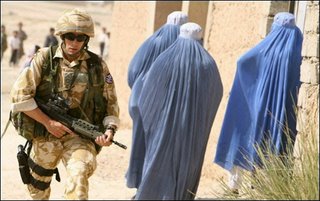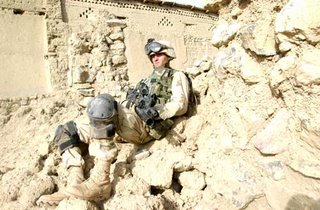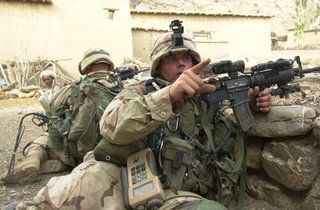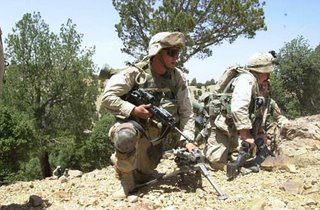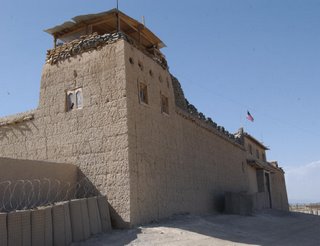Updated January 26, 2008
Friday, October 27
North of Tarin Kot, Tarin Kot District, Uruzgan Province: A vehicle carrying villagers heading to a religious celebration hit a land mine that had been laid in the road, killing 14 of the travelers.
Gangikhel, Bermal District, Paktika Province: A US Air Force B-1B attacked Taliban fighters battling US forces near here. There are bombing runs and battles around here almost every single day these days. Clearly, guerrillas are coming across the border from Waziristan to fight US forces. Gangikhel (map) is is 10 miles south of Bermal, 8 miles northeast of Shkin and 4 1/2 miles from the Pakistani border. South Waziristan is across the border.
*****
Hajji Mohammad 'Omar Khan, Murghab District, Badghis Province: British Royal Air Force GR-7 Harriers attacked guerrillas engaged with ISAF troops near here. I really do not know what guerrillas are fighting here in Badghis Province, which has only a small Pashtun population.
Hajji Mohammad 'Omar Khan (map) is located in the Murghab District near the border with Turkmenistan. It is 20 miles south of Murghab, the capital of the district. The Morghab River runs through this area.
Morghab is still populated mostly (85%) by Pashtuns, who are for the most part poor nomadic herders. The remaining 15% are mostly Tajiks and Turkmen. These Pashtuns are the descendants of Pashtuns settled here 100 years ago to act as a buffer along the border. A lot of Pashtuns moved here from Faryab Province after they were being persecuted in Faryab. They moved to Murghab because it was a safe place for Pashtuns.
The Morghab District is is hilly and is well-cultivated and most of the population lives in the Murghab River Valley. This area was hit pretty hard by the drought in recent years (although the Murghab River itself continued to flow) with livestock losses estimated at 80%. Wheat, sesame, maize, millet, watermelons and other melons are grown here, along with mulberries, apricots, carrots and turnips.
The irrigation systems, which often funnel water from rivers, are in very bad shape, with damaged embankments. 30% of the shallow wells have gone dry. The only sanitation system in the whole district is in the capital of Murghab and it is in very bad condition. The rest of the district has no sanitation at all. All roads here are in terrible condition and they all become impassible during rains, including the Herat-Mazar "highway".
There is only one health center in the whole district and it is in the capital of Murghab. Unfortunately, there are very few girls in school and employment opportunities for women in Murghab are about zero. In the rural areas there are no schools at all.
There was some serious factional fighting between Pashtun warlords here in 2003, with rapes of women and executions of rival militiamen.
The province has a mixed population of Aimaqs, Uzbeks, Tajiks, Pashtuns and Turkmen.
Tens of thousands of residents fled the province to refugee camps near Herat due to terrible drought in the late 1990's and early 2000's. Whole families actually walked the roads for months to travel to Herat or Kandahar to look for food, if you can believe that.
The drought situation has since gotten better. By 2003, 74,000 people had returned to Badghis and only 22,000 remained in the camps. Although they returned to Badghis, they in many cases have not been able to return to their villages due to harassment by warlords.
This was one of the last provinces conquered by the Taliban, and the population here never accepted them. The Northern Alliance quickly retook it and this conquest was followed by a brutal ethnic cleansing of the Pashtun population. Warlords continue to run amok here, running private jails, stealing land at will and controlling the cultivation of opium.
They run roughshod over the civilian population, extorting money from them, taxing them, harassing them, forcibly recruiting men and raping women. By 2003, there were still not enough ISAF troops here to maintain order. This is one of the most isolated provinces in Afghanistan but it is located in a strategic location right in the middle of Central Asian trade routes.
A terrible highway links the province with Herat in the south and Mazar-i-Sharif in the north. Increased opium production has recently boosted the economy here. With good precipitation in 2002-2003, the hills of the province were covered with wheat fields and there were large livestock herds. In addition to agriculture, Badghis is known as one of the carpet-making capitals of the country.
*****
Alibeg, Andar District, Ghazni Province: US Air Force A-10s attacked Taliban fighters battling US forces near here. Alibeg (map) is 13 1/2 miles south of Ghazni city, the capital of the province, and 4 miles north of Miri, the capital of Andar District. This district is now completely controlled by the Taliban. Madrassa networks are very important in the development of the Taliban here.
Garmser, Garmser District, Helmand Province: British Royal Air Force GR-7s attacked Taliban fighters in contact with British troops near here. There are air strikes and battles almost every day around Garmser.
Thursday, October 26
Band-Kajaki, Kajaki District, Helmand Province: A US Air Force B1-B Lancer and A-10 Thunderbolt IIs attacked Taliban fighters battling British troops near here. This area is right below the Kajaki Dam and sees regular fighting and air strikes for weeks now.
****
Gangikhel, Bermal District, Paktika Province: French M2000 Mirages and an Air Force B1-B attacked guerrillas fighting US troops near here. There is fighting around this area 5 miles north of Shkin along the Pakistani border with South Waziristan most every single day now. The map and location description of Gangikhel are above.
The Pakistani fundamentalist jihadi group Jaish-e-Mohammad, a group dedicated to liberating Kashmir, has also participated in attacks around here, and claimed responsibility for an October 23, 2003 attack that killed 2 CIA agents in Shkin.
****
****
Payandeh, Jaghatu District, Ghazni Province: Air Force A-10s provided close-air support for ISAF troops in contact with Taliban extremists near here. There are 3 Payandehs - one in Kabul Province, another in Wardak Province and another in Ghazni Province.
This fighting is probably taking place in Ghazni, as air strikes in Kabul and Wardak Provinces rarely occur, while they are common in Ghazni. Payandeh (map here) is 10 miles north of Ghazni. I am not aware of much fighting in this district. The Jaghatu District is 73% Hazara and 27% Pashtun.
*****
Wednesday, October 25
*****
Koh-e-Sayad, Shirin Tagab District, Faryab Province: A member of the provincial council, Syed Noor Mohammad Agha, was assassinated here by 2 gunmen on a motorcycle. His guard was wounded in the attack. The motive for the attack was not known as the Taliban do not have much of a presence in this district.
The province is primarily Uzbek and Tajik, although there are some Pashtuns and there is a significant Turkmen population here. Warlords continue to run amok here, especially Rashid Dostum, the Uzbek super-criminal, who reportedly has his own jails here.
Warlords are involved in many land seizures here. Since the overthrow of the Taliban, there have been significant efforts at reforestation of this province, as it was heavily deforested. The Shirin Tagab District is populated mainly by Turkmen.
 Severe overgrazing in Faryab Province. This land is barren now and not even a sheep or a goat can find a morsel to eat here.
Severe overgrazing in Faryab Province. This land is barren now and not even a sheep or a goat can find a morsel to eat here. A breathtaking photo of the city of Faryab, capital of Faryab Province, in a green valley surrounded by barren hills. This photo was taken by a US soldier. As you can see, there are quite a few trees in the city of Faryab.
A breathtaking photo of the city of Faryab, capital of Faryab Province, in a green valley surrounded by barren hills. This photo was taken by a US soldier. As you can see, there are quite a few trees in the city of Faryab.*****
Khakeran, Day Chopan Province, Zabul Province: US Air Force A-10 Thunderbolt IIs dropped a 500-lb bomb on Taliban fighters fighting US troops near here. Khakeran (map here and here) is located 25 1/2 miles northeast of Day Chopan, the capital of the district in the northern part of the province near the border with Uruzgan.
Band-e Kajaki, Kajaki District, Helmand Province: British Royal Air Force GR-7 Harriers attacked Taliban fighters battling British forces near here. There is fighting near the Kajaki Dam all the time. It's clearly Taliban Central.
Tuesday, October 24
****
Lay Kundi, Mirwisa Mina, Zangabad and Sperwan, Panjwayi District, Kandahar Province, AM : NATO forces said they killed 48 Taliban here in 3 separate battles. The governor of the Panjwayi District, however, reported that 60 civilians had been killed in the air raids and a number of houses had been destroyed. This assertion was backed up by 2 other government officials, who said that 60-85 civilians were killed.
Other reports said that 40-85 civilians had been killed. The village was hit by NATO mortar, artillery and air strikes.Taliban fighters reportedly took refuge in local homes and those homes were then attacked from the air. Villagers said that the dead were nomads, possibly Kuchi nomads, who were living outside the village in tents.
 A sheep flock being grazed by Kuchi nomads outside Kandahar city. Kuchis are well tolerated by most of Afghanistan's ethnic groups, even though they are not necessarily classed with the main groups such as Pashtuns, Tajiks, etc. They travel through, ask to graze in the local fields, and move on, in a timeless manner.
A sheep flock being grazed by Kuchi nomads outside Kandahar city. Kuchis are well tolerated by most of Afghanistan's ethnic groups, even though they are not necessarily classed with the main groups such as Pashtuns, Tajiks, etc. They travel through, ask to graze in the local fields, and move on, in a timeless manner.The dead civilians were creating a crisis for the Karzai regime as it scrambled to try put the best face on the matter.
The initial attack occurred when 40 guerrillas attacked a NATO base. Then the same group apparently attacked an Afghan army base in the same area. A second attack occurred near dusk at a Canadian Base called FOB Wilson when a group of Taliban in a truck were spotted south of the base and attacked with artillery.
The final attack occurred near Sperwan, where a large group of Taliban apparently were congregated. Air strikes were called in. This is apparently where the civilian casualties occurred.
Most of the dead civilians were reported from a place called Sperwan Ghar in the Panjwayi District, which could not be found on any map. However, a town called Sperwan definitely exists. Sperwan (map) is 19 miles southwest of Panjwayi, the capital of the district. Lay Kundi and Mirwasi Mina could not be located on any map, nor could Zangabad, but they are apparently near Sperwan.
This town was where Mullah Omar was reportedly holed out with a group of hardcore followers in January 2002 after the US invasion. Soon afterwards, he reportedly fled to the Baghran District of northern Helmand Province on a motorcycle.
A predominantly military project in this area is clearly not going to work, as the excellent article by Elizabeth Rubin in New York Times Magazine notes. It's an excellent first part of a 2-part series on Afghanistan that shows that this mess is a lot more complicated than a lot of folks think it is.
*****
*****
Kandahar-Kabul Highway, Zabul Province: Officials seized 10 tons of marijuana from a vehicle on this highway. 5 men were arrested. Although cannabis is illegal here, the focus of narcotics officers, such as it is, is on opium and heroin instead. Quite a few Afghans, especially older males, smoke cannabis, usually in the form of hashish.
It is associated with Sufi orders, which are still quite popular here despite the influence of Salafism, Wahhabism and other forms of Sunni Islam hostile to Sufism.
*****
*****
Farah Province: Officials seized 120 pounds of opium from a vehicle here. A car failed to stop at a checkpoint manned by US and Afghan troops. It was then chased down and the opium was seized. 610 tons of opium of opium were grown in Afghanistan this year, exceeding the world demand for heroin by 33%.
One out of every 8 Afghans is involved in growing opium, or 2.9 million Afghans. Opium cultivation is especially important in Helmand Province and to a lesser extent in Kandahar Province. It is also grown in Nangarhar and in particular Badakhshan Province in the north. Opium cultivation is a major factor driving the Taliban insurgency in Helmand and Kandahar.
*****
****
Garmser, Garmser District, Helmand Province: A US Air Force B-1 Lancer attacked Taliban fighters battling British troops near here. Garmser is chronically unstable and there have been regular air strikes here for weeks or even months now with no apparent end in sight.
The degree of support that the Taliban now has in Helmand is shocking. Something needs to be done quickly to arrest this trend. For starters, the crooked governor of Helmand needs to be removed.
*****
Sardaran, Panjwayi District, Kandahar Province: A US Air Force B-1 Lancer attacked Taliban fighters battling NATO forces near here. Sardaran (map here) is located 2 miles west of Panjwayi. This airstrike may be related to the disastrous airstrike above that killed 60-85 civilians.
Monday, October 23
Pech District, Kunar Province: US forces fired mortars at guerrilla positions here and one of the shells fell short, hitting a home and killing 3 children. Troops were firing mortars into areas where they been attacked earlier.
Bermel Rod, Bermal District, Paktika Province: US Air Force A-10 Thunderbolt IIs and an Air Force B-1 Lancer attacked guerrillas battling ISAF forces near here, dropping GBU-31's and GBU-38's on the guerrillas. Bermal Rod is located between Rajim Sa (map) and Jabin Kot (map) near the Pakistani border, 5 miles north of the dangerous US firebase at Shkin. South Waziristan is across the border.
Eybak, Samangan Province: British Royal Air Force Harrier GR-7s attacked unknown guerrillas fighting ISAF troops near here. This area has been bombed before. The guerrillas in this area are mysterious and unknown.
Kandahar: A US Air Force B-1 attacked Taliban forces in contact with NATO forces near here.
Sunday, October 22
*****
Waryan, Shinand District, Herat Province, afternoon: Heavy fighting erupted between the forces of two warlords here, killing 32 combatants. The fighting broke out between the forces of Amanullah Khan, a Pashtun commander who has frequently fought with his Tajik rivals. However, this time, he fought with Arbab Basir, another Pashtun warlord. The fighting broke out when Khan's forces entered an area controlled by Basir's forces.
Hundreds of men armed with RPG's, heavy machine guns and automatic weapons took part in the idiotic fighting. The warlords gained power with the mujahedin fighting Soviet troops sponsored by US imperialism and Saudi and Pakistani Islamic fundamentalist regimes. It was this mujahedin movement that eventually created the Taliban and Al Qaeda and gave a shot in the arm to jihadi loons all over the Muslim World.
After the overthrow of the Taliban, many of these criminals remain in power, despite a movement to get them to turn in their guns. Waryan could not be located on any map.
*****
******
Laghman Province: Officials seized a large quantity of bomb making materials here. 2 trucks carrying over 150 75-pound bags of ammonium nitrate and 159 cans of ammonium paste were seized.
 A field in Laghman Province. This area south of Kabul is heavily Pashtun, although it has not seen a lot of fighting recently. After being routed in Paktia Province during Operation Anaconda in early 2002, Ayman Zawahiri, Al Qaeda's second in command, reportedly moved to an area of Laghman Province that strongly supported the Taliban and Al Qaeda. This was in about January or February 2002.
A field in Laghman Province. This area south of Kabul is heavily Pashtun, although it has not seen a lot of fighting recently. After being routed in Paktia Province during Operation Anaconda in early 2002, Ayman Zawahiri, Al Qaeda's second in command, reportedly moved to an area of Laghman Province that strongly supported the Taliban and Al Qaeda. This was in about January or February 2002. The site of a school being built in Laghman Province. At least someone is building some schools somewhere in Afghanistan. There needs to be much more like this, except the US Republican Party is totally hostile to public education everywhere on Earth, so I guess there won't be much school building.
The site of a school being built in Laghman Province. At least someone is building some schools somewhere in Afghanistan. There needs to be much more like this, except the US Republican Party is totally hostile to public education everywhere on Earth, so I guess there won't be much school building.*****
*****
Garmser, Garmser District, Helmand Province: A US Air Force B-1 Lancer and British Royal Air Force Harrier GR-7s attacked Taliban fighters battling British troops near here. There is now almost daily bombing around the Garmser area.
*****
Mangratay, Khost Province: An Air Force B-1 attacked guerrillas fighting US forces near here. There have been regular bombing runs around this town recently. The town could not be located on any map.
 2 older men and a younger man relaxing inside a building. Note the beautiful Afghan rug and the pillows. Those rugs will probably fetch a good figure in the West.
2 older men and a younger man relaxing inside a building. Note the beautiful Afghan rug and the pillows. Those rugs will probably fetch a good figure in the West. Boys in school in Khost Province. Hey, at least they are indoors! Thank God for small favors, kids. Check out the caps and the carpets.
Boys in school in Khost Province. Hey, at least they are indoors! Thank God for small favors, kids. Check out the caps and the carpets.*****
*****
Gereshk, Nahri Sarraj District, Helmand Province: An Air Force B-1 and RAF GR-7s attacked Taliban fighters battling British forces here. There seems to be chronic fighting around Gereshk for some time now.
Gereshk was the capital of Helmand Province until 1957, when it was supplanted by the new city of Lashkar Gah, a city that was created by the Helmand-Arghandab Irrigation Project that the Afghan government hired the US government to do on the Helmand River. Gereshk is along the Kandahar-Herat Highway and as such it was an important town.
After Lashkar Gah became capital, Gereshk was supplanted. The economy of Gereshk is now deeply tied into Kandahar and Lashkar Gah. There are not many government offices in town anymore, most having moved to Lashkar Gah. The bazaar in town only sells food products.
*****
*****
Lwara Dasta, Gayan District, Paktika Province: A US Air Force B-1 attacked guerrillas who were fighting US troops near here. This is the location of a US firebase on the border with Pakistan that is seeing a lot of action lately. It is right across from North Waziristan.
The areas of Afghanistan across from the Waziristans have seen an increase of three times in the number of attacks since a truce was signed with locals and the Pakistani government. The Taliban and Al Qaeda now rule the area. The have instituted Islamic law and it is true that crime has gone down, especially armed robbery. Waziristan is a strange place.
Many of the males here are involved in chronic feuds with other families or towns. Frequently these feuds have lasted for 40 years or more. The best job to get is with the government, because the job gives you some protection against the feuds. If one goes to work in the bazaar, one will often be killed quite quickly by one's feuding enemies.
The men here sire large families as a sign of masculinity. The women are completely kept down and have no involvement whatsoever in public affairs. They are usually not even seen outside the home. The people here are very poorly educated and many are illiterate. Often the only available education is in the madrassas.
Now, the fundamentalist cretins are issuing decrees saying that the only book that should be read is the Quran. A lot of money is flowing into the area from fundamentalist barbarians in the Gulf, and the money is going straight to the madrassas run by fundamentalist idiot clerics.
If you want to access any of the services in the area, you have to go through the clerics, who are monopolizing the money in the area. Such is the dilemma that the Waziristanis face. As you can see, not all of them necessarily support the fundamentalist creeps, but in such an area, it is not as if one has a lot of choice.
In fact, many of the traditional leaders refused to support the jihadis. Hence, large numbers of the traditional leadership were killed off by the jihadis. Now that the traditional leadership structure has been decimated, it is easy for the Islamist boneheads to move in and assume control.
In the past year in North Waziristan, many girls schools have been burned down. Although some Waziristanis support that, others surely do not.
The picture is quite complex - more complex than the "Waziris love the fundamentalist jihadis" sound bite.
*****
Saturday, October 21
*****
Ismail Khel, Khost Province: Roadside bomb attack on the intelligence chief of the province killed the chief.
 One of George Bush's delightful "classrooms" in Khost Province. I wonder how Bush would like to go to a school like this? When Afghans say that we have been here 5 years with nothing to show, they are not kidding, sometimes.
One of George Bush's delightful "classrooms" in Khost Province. I wonder how Bush would like to go to a school like this? When Afghans say that we have been here 5 years with nothing to show, they are not kidding, sometimes.*****
****
Gayan District, Paktika Province: An airstrike reportedly killed 5 Taliban here. This is part of Operation Mountain Fury. There have been regular air strikes here and in other areas of Eastern Paktika for the last couple of weeks, probably all as part of this Operation. North Waziristan is across the border.
Zabul Province: Guerrillas attacked a US convoy with RPG's and automatic weapons, sparking a battle in which 15 Taliban were said to have been killed. 2 US troops were wounded in the fighting.
Bar Kanday, Pech District, Kunar Province: US Air Force A-10s Thunderbolt IIs fired cannon rounds at guerrillas battling US forces near here. There are regular battles and airs trikes here. Bar Kanday (map) is 13 miles east of Asadabad in the Pech River Valley.
Garmser, Garmser District, Helmand Province:US Air Force A-10s dropped a 500-pound bomb and fired cannon rounds at Taliban forces battling British troops near here, in an area that sees fighting almost every day. The A-10s dropped a general-purpose 500-pound bomb and fired cannon rounds on the Taliban.
Friday, October 20
*****
Khost Province, Early: US forces raided a cell that was making roadside bombs here. One guerrilla tried to resist and was shot and killed by soldiers. Bomb-making materials were confiscated.
 School is in session, kids! Although the class in Khost Province is all boys, they actually have both a male and a female teacher teaching them. In Afghanistan, that is called revolutionary.
School is in session, kids! Although the class in Khost Province is all boys, they actually have both a male and a female teacher teaching them. In Afghanistan, that is called revolutionary.*****
*****
Khost: A suicide bomber walked up to an Afghan army convoy and detonated himself, killing himself and a soldier. 7 soldiers and 3 civilians were also wounded in the attack. There are now regular suicide bombings in Khost in what is an ominous development.
The insurgency in Khost is led by Jalalludin Haqqani, a former Taliban commander who has managed to utilize the madrassa network in the area to form a solid basis of support for the Taliban insurgency. Haqqani also has a lot of power in Paktia Province and in the Waziristans, especially North Waziristan. In truth, Haqqani controls the Taliban insurgency in both the Waziristans and in all of Southern Afghanistan.
 A "school" in Khost Province. It is not in session. Thanks a lot, George Bush! After 5 years in Afghanistan, this is the best that Bush can do for the Afghan people. A school under a shade tree, like in America in the 1830's.
A "school" in Khost Province. It is not in session. Thanks a lot, George Bush! After 5 years in Afghanistan, this is the best that Bush can do for the Afghan people. A school under a shade tree, like in America in the 1830's.The Bush reactionaries threaten and even attack any country in Latin America that dares to spend money on schools, medical care, housing, roads, literacy, etc. Aristide in Haiti built more schools in that country than in the entire history of Haiti from 1804-1994.
For this crime, George Bush, along with France and Canada, overthrew his government, ordered Aristide to vacate the country by pointing a gun at his head, and installed a death squad regime that has murdered 3,000 Haitians who supported Aristide for doing evil stuff like building schools.
Considering how hostile the US is towards all social spending (the US calls that "socialism") why should we expect America to engage in "socialist" social spending in Afghanistan? We should not.
 Indoors, much better. Also in Khost Province. These girls are actually in school. At this early age, they already need to cover their hair? Why, to protect themselves from child molesters like John Mark Karr? In this very conservative province, these girls are lucky to be in school at all.
Indoors, much better. Also in Khost Province. These girls are actually in school. At this early age, they already need to cover their hair? Why, to protect themselves from child molesters like John Mark Karr? In this very conservative province, these girls are lucky to be in school at all.Can you believe that Khost Province was one the hotbeds of support for the Communist government in the 1980's? Neither can I? At the same time, it was also one of the first provinces to expel the Soviet troops.
Afghan politics is nothing if not complicated and has more to do with tribal affiliation than such abstract concepts as Communism or capitalism. Not that capitalism has much relevance here anywhere. In fact, we can posit that capitalism has thoroughly failed in Afghanistan.
*****
*****
Shem Kheyl, Jaji Mandan District, Khost Province: US Air Force A-10 Thunderbolt IIs attacked guerrillas battling US forces near here. Shem Kheyl (map) is 20 miles northwest of Khost City, 7 miles west of Jaji Mandan, the capital of the district, and only 8 miles from the Pakistani border.
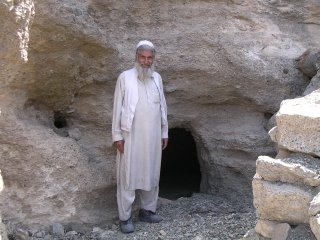 An old man stands next to what appears to be a cave in Khost Province. The text describing the photo was in German so I am guessing at the content of the photo.
An old man stands next to what appears to be a cave in Khost Province. The text describing the photo was in German so I am guessing at the content of the photo.*****
****
Musa Nikeh Ziarat, North Waziristan, Pakistan: US Air Force A-10 Thunderbolt IIs attacked guerrillas in contact with US forces near here. I assume that the fighting was just on the border, as this town is actually in Pakistan. There seems to be heavy fighting going on almost every day here in the Bermal and Gayan Districts on the Pakistani border these days.
Moza Nikeh Ziarat is right over the border into the South Waziristan region of Pakistan. I assume that the fighting was right on the border, or possibly the airstrike was in Pakistani territory - who knows. There is fighting and bombing around Shkin and especially within 5 miles to the north of it on a regular basis the past few weeks.
*****
Garmser, Garmser District, Helmand Province: Royal Air Force GR-7s attacked Taliban forces fighting British troops again near here, in what is almost daily fighting now.

